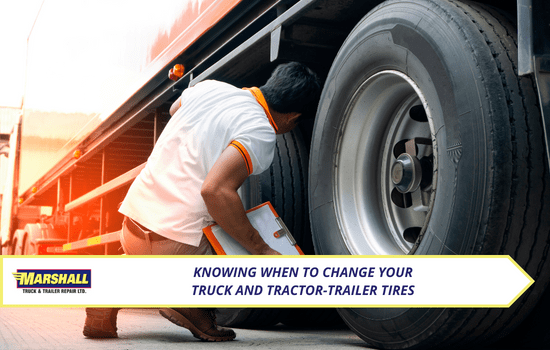Tires are a critical component of trucks and tractor-trailers, playing a vital role in ensuring safe and efficient transportation. Understanding when to change tires and prioritizing their maintenance is paramount.
Tire Talk: A Guide to Perfect Timing for Changing Truck and Tractor-Trailer Tires
 Knowing when to change your truck and tractor-trailer tires is crucial for maintaining road safety, optimizing fuel efficiency, and preventing costly breakdowns. In this blog, we'll explore the key indicators and factors that help determine the right time to replace these essential components.
Knowing when to change your truck and tractor-trailer tires is crucial for maintaining road safety, optimizing fuel efficiency, and preventing costly breakdowns. In this blog, we'll explore the key indicators and factors that help determine the right time to replace these essential components.
1. Tread Depth
Tread depth is one of the most important factors when it comes to tire replacement. In most regions, including Canada and the United States, the legal minimum tread depth for truck and tractor-trailer tires is typically 2/32 of an inch (about 1.6 millimetres). However, it is strongly recommended to replace tires well before they reach this minimum legal tread depth.
For safety and optimal performance, many experts advise replacing truck and tractor-trailer tires when the tread depth reaches around 4/32 of an inch (approximately 3 millimetres). It is important to note that steer tires should be no less than 4/32 of an inch (approximately 3 millimetres). Tires with adequate tread depth provide better traction, especially in wet or slippery conditions, and help prevent hydroplaning.
2. Irregular Wear
Inspect your tires regularly for signs of irregular wear. Irregular wear patterns, such as cupping, scalloping, or uneven wear on one side of the tire, can indicate alignment or suspension issues that need to be addressed. If you notice such patterns, it's essential to diagnose and resolve the underlying problem promptly and consider replacing the affected tires.
3. Age of Tires
Even if a tire has sufficient tread depth and appears to be in good condition, it may still require replacement due to its age. Truck and tractor-trailer tires have a recommended service life, check with your tire manufacturer to know. Beyond this period, the structural integrity of the tire can deteriorate, making it more susceptible to blowouts or failures. Always check the tire's sidewall for the manufacturing date (usually in a DOT code) to determine its age.
4. Visual Inspections
Regular visual inspections of your truck and tractor-trailer tires are crucial. Look for any visible damage, such as cuts, punctures, bulges, or cracks in the sidewall or tread area. Any of these issues can weaken the tire's structure and increase the risk of tire failure. If you find such damage, consider replacing the tire immediately.
5. Load and Speed Ratings
Make sure your truck and tractor-trailer tires have the appropriate load and speed ratings for your specific application. Using tires with inadequate load capacity can lead to premature wear and potential tire failure. Likewise, exceeding the speed rating can generate excessive heat, causing tire damage or blowouts.
